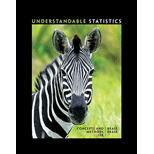
Concept explainers
(a)
Delineate the basic ideas behind the chi-square test of independence.
Define a
Provide the null and alternative hypotheses.
Explain how the test statistic is constructed.
Give the basic assumptions that underlie the application of the chi-square distribution.
(a)
Explanation of Solution
Chi-square test of independence:
A single simple random sampling is done with each individual being classified based on the two categorical variables. Then, the hypothesis testing is carried out to check whether there is any relationship between the two categorical variables. This test is called chi-square test of independence.
Contingency tables:
The data from the two variables of a population are known as bivariate data and the frequency distribution for the bivariate data is known as the contingency table.
The test hypotheses are given below:
H0: The variables are independent.
H1: The variables are not independent.
Test statistic for the chi-square test of independence:
Where, the sum is over all the cells in the contingency table.
R= number of rows in a contingency table.
C= number of columns in a contingency table.
E= expected frequency.
For each cell, the value of the expected frequency is obtained as given below:
The basic assumptions underlie the application of the chi-square as given below:
In order to apply the chi-square distribution, the sample size should be large so that for each cell,
(b)
Delineate the basic ideas behind the chi-square test of goodness of fit.
Provide the null and alternative hypotheses.
Explain how the test statistic is constructed.
Discuss and summarize the similarities between the tests of independence and tests of goodness of fit.
(b)
Explanation of Solution
Chi-square test of goodness of fit:
The test of goodness of fit enables people to see how well does a specific (theoretical) distribution fits the observed data. Then, the hypothesis testing is carried out to check whether a frequency distribution follows a claimed distribution or not.
Chi-square test of goodness of fit is a test that provides conformation between the observed frequencies (Oi) the expected frequencies (Ei) for several categories.
In a goodness of fit, the following is obtained:
O= Observed frequency count of a category.
E= Expected frequency of a category.
The value of the expected frequency will be as given below:
The test hypotheses are given below:
H0: The population fits the specified distribution of categories.
H1: The population has a different distribution.
Test statistic for the chi-square test of goodness of fit:
Where, the sum is over all the cells in the contingency table and k= number of categories.
The basic assumption that underlies the application of the chi-square is as given below:
In order to apply a chi-square distribution, the sample size should be large so that for each cell,
Similarities between the tests of independence and the tests of goodness of fit:
Normally, the chi-square test is used to compare the frequencies of one category variable to the theoretical distribution (test of goodness of fit) and to compare the frequencies of one category variable to the different values of a second categorical variable (test of independence).
Therefore, both tests take a categorical variable to perform the hypothesis.
(c)
Delineate the basic ideas behind the chi-square method of testing and estimating a standard deviation.
Give the basic assumptions that underlie the application of the chi-square distribution.
(c)
Explanation of Solution
If the standard deviation of a population standard deviation is equal to a specified value, then the chi-square method of testing and estimating a standard deviation is used. It is applicable only when random variable x has a
The basic assumptions that underlie the application of the chi-squareis are given below:
- Sample selected is a random sample.
- The distribution of observation should be approximately normal.
(d)
Delineate the basic ideas behind the chi-square test of homogeneity.
Provide the null and alternative hypotheses.
Explain how the test statistic is constructed.
Give the basic assumptions that underlie the application of the chi-square distribution.
(d)
Explanation of Solution
Chi-square test of homogeneity:
Independent simple random samples are taken from two or more populations, where every individual is being classified based on one categorical variable. Here, the hypothesis testing is done to check whether any homogeneity exists. In other words, the homogeneity tests claim that different populations are from the same proportions of specified characteristics. This test is called the chi-square test of homogeneity.
The test hypotheses are given below:
H0: The proportion of each population sharing specified characteristics is the same for all populations.
H1: The proportion of each population sharing specified characteristics is not the same for all populations.
Test statistic for the chi-square test of independence:
Where, the sum is over all the cells in a contingency table.
R= number of rows in the contingency table.
C= number of columns in the contingency table.
E= expected frequency.
For each cell, the value of the expected frequency is obtained as given below:
The basic assumption that underlies the application of the chi-square is given below:
In order to apply the chi-square distribution, the sample size should be large so that for each cell,
Want to see more full solutions like this?
Chapter 10 Solutions
Understandable Statistics: Concepts and Methods
 Glencoe Algebra 1, Student Edition, 9780079039897...AlgebraISBN:9780079039897Author:CarterPublisher:McGraw Hill
Glencoe Algebra 1, Student Edition, 9780079039897...AlgebraISBN:9780079039897Author:CarterPublisher:McGraw Hill Big Ideas Math A Bridge To Success Algebra 1: Stu...AlgebraISBN:9781680331141Author:HOUGHTON MIFFLIN HARCOURTPublisher:Houghton Mifflin Harcourt
Big Ideas Math A Bridge To Success Algebra 1: Stu...AlgebraISBN:9781680331141Author:HOUGHTON MIFFLIN HARCOURTPublisher:Houghton Mifflin Harcourt
 College Algebra (MindTap Course List)AlgebraISBN:9781305652231Author:R. David Gustafson, Jeff HughesPublisher:Cengage Learning
College Algebra (MindTap Course List)AlgebraISBN:9781305652231Author:R. David Gustafson, Jeff HughesPublisher:Cengage Learning Holt Mcdougal Larson Pre-algebra: Student Edition...AlgebraISBN:9780547587776Author:HOLT MCDOUGALPublisher:HOLT MCDOUGAL
Holt Mcdougal Larson Pre-algebra: Student Edition...AlgebraISBN:9780547587776Author:HOLT MCDOUGALPublisher:HOLT MCDOUGAL Calculus For The Life SciencesCalculusISBN:9780321964038Author:GREENWELL, Raymond N., RITCHEY, Nathan P., Lial, Margaret L.Publisher:Pearson Addison Wesley,
Calculus For The Life SciencesCalculusISBN:9780321964038Author:GREENWELL, Raymond N., RITCHEY, Nathan P., Lial, Margaret L.Publisher:Pearson Addison Wesley,





